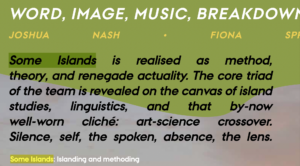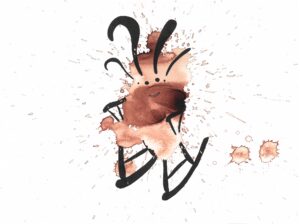When Peter Bakker approached me to write a review of the first issue of Some Islands. A Journal of Linguistics and Art , edited by Joshua Nash, he made it quite clear why he approached me, of all people: “you do art and linguistics. Would you like to review this for Lingoblog? It is about art and linguistics”. When I saw the title page of this new experimental journal, it was difficult to say no. But little did I know what I was letting myself in for.

Why islands? Why a chair? Why some islands? And why this sort of chair?
As I read on, I decided to stay open-minded, sit in it for a while and see where that takes me.

Plunging into the editorial in hope to find out, I couldn’t but start wondering however why I (or anyone) should write a review of Some Islands, since “not giving a fuck” is “a modus operandi” of the whole endeavour. At the same time, it was quite obvious that a lot of thinking and work has gone into this new journal (ad)venture, and certain aspects of the volume resonated with me quite deeply (so a fuck was given after all).
This is not your typical linguistics / language studies journal, and so this is not going to be a typical review.
If you decide to pay a visit to Some Islands, you can look forward to engaging lively visuals and to leaps into the unknown – and remaining very much in the unknown till the final page, and beyond. If you expect linguistics, you shall not find “regular” linguistics – very much on purpose. In fact, you will find very little linguistics indeed (in my opinion at least). What you’ll find instead is what I would call philosophising and aesthesising about language (should this not be part of linguistics?), but mainly about islands and all sorts of other existential things – a certain type of somethingness about language-there-ness (to adopt the expressive air of the authors).
The main goal of the journal, as announced in the editorial, is to engage with this question: “Can artistic, aesthetic, and creative endeavours help us as much as linguistic science does in our appreciation and understanding of what language is and how it works?” The answer to this bigger question provided by the editor/band is positive. And I agree, though it’s not Some Islands that led me to this conclusion.
Here are the questions raised in the first volume of Some Islands which spoke to me most (not necessarily phrased as such by the authors):
- Why do we linguists (and scientists more generally) take ourselves so seriously?
- Have the usual outlets for linguistic (and more generally scientific) publications become too rigid? With the publication demands on academics in the incessantly rolling wheel of universities and other research institutions, do we have a chance to keep on top of the information produced?
- What degrees of interdisciplinarity are possible? Can arts and science be combined in a meaningful interdisciplinary way?
- What is linguistics? What’s the point of linguistics? Who is linguistics for, really? (And where does language-there-ness fit in?)
- Do linguists exploit the speakers they work with? (We know we do.)
- How are we constrained by our disciplinary lenses?
- How can we best share our knowledge with the world beyond academia?
- Does any of this really matter?
The journal also undoubtedly offers treasure troves of gems that not every linguistically-minded reader might appreciate. Readers beware – tis not for everyone. But it can be refreshing to boldly go if you dare. Some of the things that might get your goat include:
- The discussions being necessarily coloured by the authors’ backgrounds. We don’t all have the same backgrounds and the same assumptions about the world and language, Language, and languages. Get exposed to the text though and see what happens to you.
- “The wonky assumption that language is indeed an analysable scheme is more than merely a simple stretch.”
- And I must admit, I did see a “wtf” written in one of the notes I made while exploring the volume. But then again, not giving a fuck is the modus operandi, so this seems to be in the overall spirit of the journey.

My reaction to what seems to constitute an island.
Chairs and islands can be found throughout the issue, and I still don’t quite comprehend. But that’s ok. I’m oscillating between the hilariousness of this work and the fact that anything seems to be fittable within the metaphor of an island (musical instruments included, and so much more).
As the editor writes, one of the band members has said “several times that he has no idea what Some Islands is even about. Join the club.”
I know I have!
Míša Hejná’s interests lie in sociolinguistics, language variation and change, phonetics, and interdisciplinary studies. She researches things to do with phonatory phenomena (=voice things). The human (and non-human) voice is where she connects her academic and non-academic interests most. You can check out her visual artwork here and bump into her here and there in the poetry scene of Aarhus.









1 thought on “Experimental and Edgy Linguistics Somethingness: Sexy Syntax, Phenomenal Phonology, Phonetic Phenomenology, and Not Giving a Fuck”